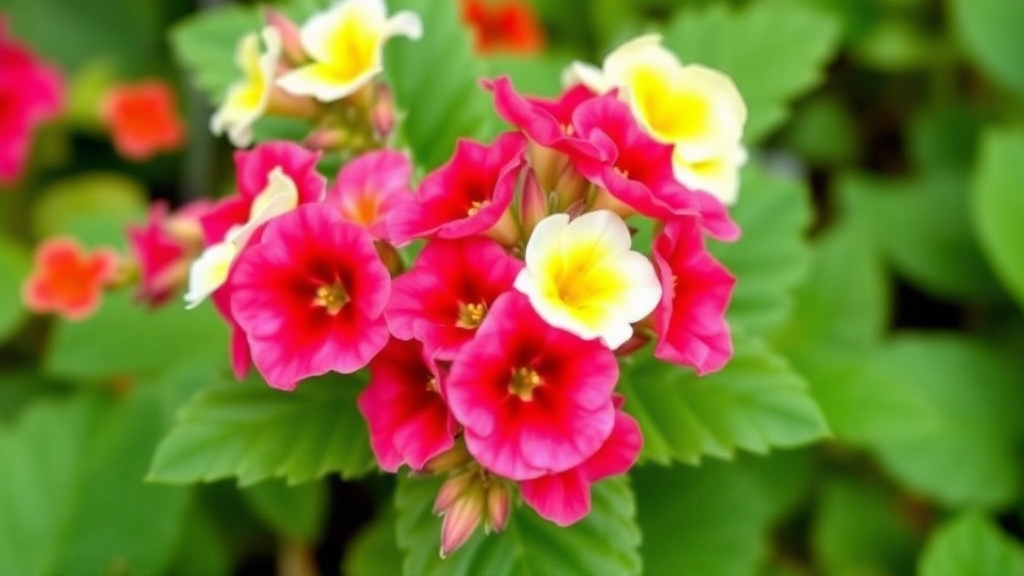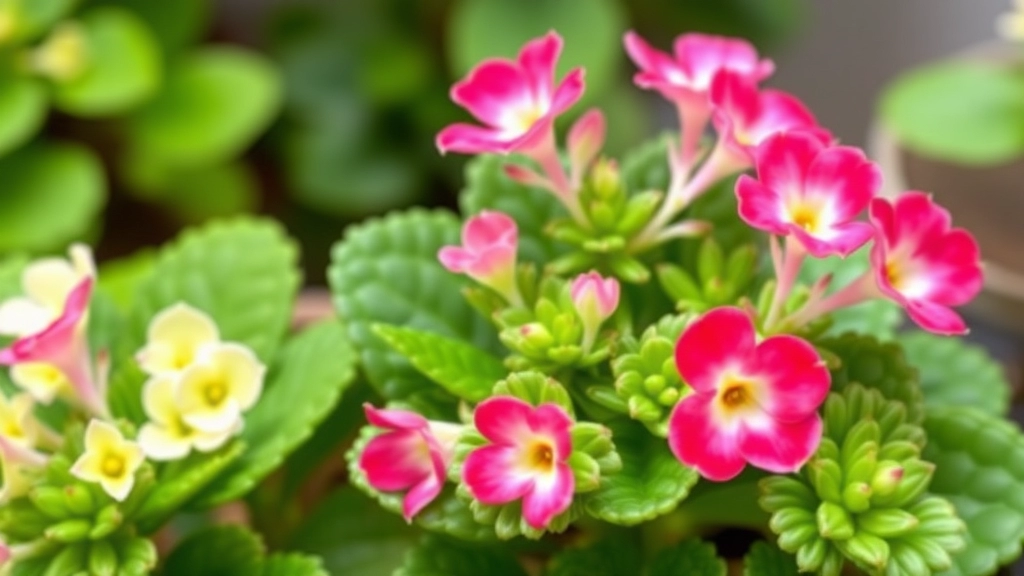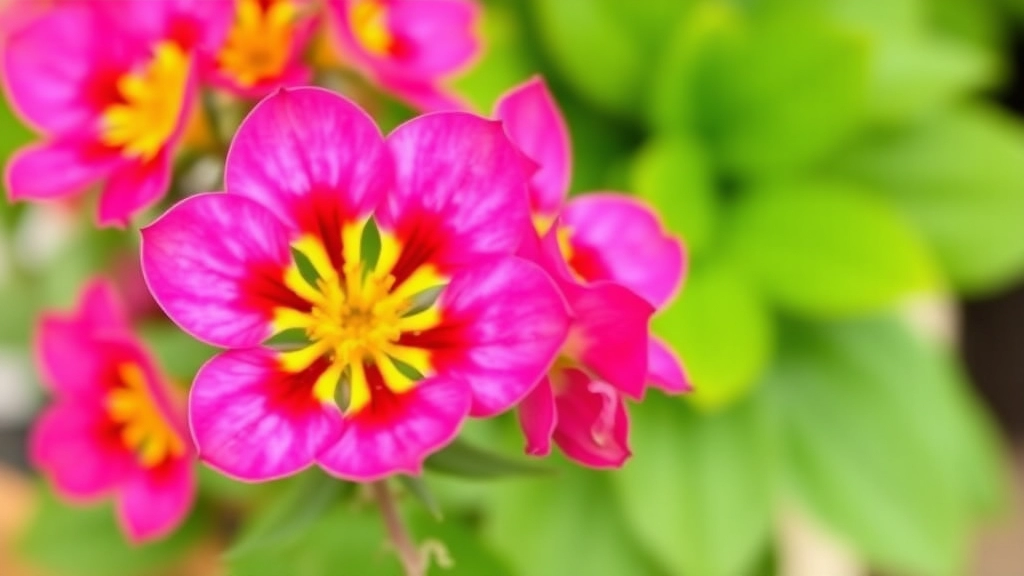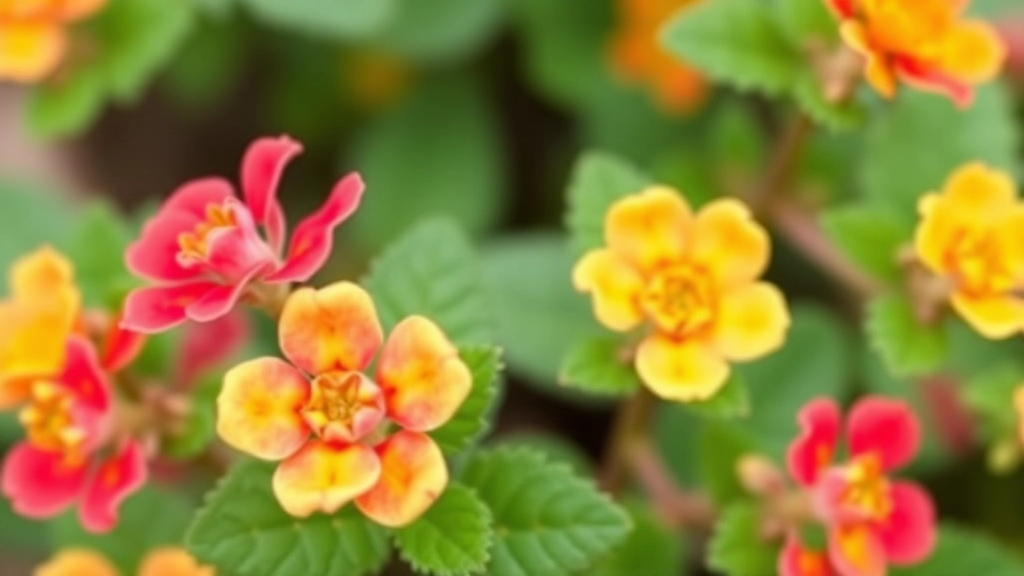Florist Kalanchoe
When it comes to the Florist Kalanchoe, its common name is often just “Kalanchoe,” but you’ll also hear it referred to as “Flaming Katy” or “Christmas Kalanchoe.” These vibrant plants are a favourite among indoor gardeners for their colourful blooms and easy care.
Popular Varieties
There are several popular varieties of Kalanchoe, each with its unique charm. From the classic Kalanchoe blossfeldiana to the striking Kalanchoe thyrsiflora, these plants thrive in bright, indirect light and require minimal watering.
Choosing the Right Kalanchoe
Whether you’re a seasoned gardener or a newbie, understanding the common names and varieties helps in selecting the perfect Kalanchoe for your space.
Common Names of Kalanchoe
When you’re exploring the world of houseplants, you might come across the enchanting Kalanchoe.
What exactly are the common names associated with this delightful succulent?
Kalanchoe, belonging to the Crassulaceae family, is often referred to by several names that highlight its unique characteristics and appeal.
Common Names
- Flapjack Plant: This name comes from the plant’s distinctive, flat leaves that resemble pancakes. Learn more about its care in our Kalanchoe Flapjack Paddle Plant Care Guide.
- Mother of Thousands: Known for its ability to produce numerous offsets, this name reflects its prolific nature. For easy propagation tips, check out our guide on How to Propagate Kalanchoe Mother of Thousands.
- Chandelier Plant: Some varieties have a cascading growth habit, earning this charming moniker.
- Kalanchoe Blossfeldiana: Often called simply “Kalanchoe,” this specific variety is popular for its vibrant blooms.
These names not only make it easier to identify the plant but also hint at its fascinating traits.
Popular Kalanchoe Varieties and Their Names

So, you’re curious about the different types of Kalanchoe, right? You’re not alone! These plants come in a delightful variety of shapes, sizes, and colours, making them a favourite for both indoor and outdoor gardens.
Common Varieties
Here are some popular Kalanchoe varieties you might want to consider:
- Kalanchoe blossfeldiana: This is the classic florist Kalanchoe. You’ll recognise it by its vibrant clusters of flowers, often in shades of red, pink, and yellow. It’s a cheerful addition to any space!
- Kalanchoe tomentosa: Also known as “Panda Plant,” this one has fuzzy leaves that look like they’re covered in a soft coat. The silvery-green leaves are edged with a hint of brown, giving it a unique flair.
- Kalanchoe luciae: Known as the “Flapjack” or “Paddle Plant,” it has thick, flat leaves that resemble pancakes stacked on top of each other. The leaves can turn a lovely red hue when exposed to bright sunlight.
- Kalanchoe beharensis: This is the “Elephant Ear” plant. Its large, thick leaves are textured and can grow quite big, making it an eye-catching feature in any garden.
- Kalanchoe marmorata: Commonly called “Pencil Plant,” it has striking marbled leaves that can add a touch of drama to your collection.
Why They Matter
Each variety has its charm and care requirements, so knowing which one you want can help you provide the best environment for it.
For instance, if you’re after something that blooms profusely, Kalanchoe blossfeldiana is your best bet. But if you want a conversation starter, the unique Kalanchoe tomentosa might steal the show.
Growing Conditions for Florist Kalanchoe
When it comes to growing Kalanchoe, many people wonder about the ideal conditions to ensure vibrant blooms and healthy foliage.
Light Requirements
Florist Kalanchoe thrives in bright, indirect sunlight.
- Ideal Location: A south or west-facing window is perfect.
- Duration: Aim for about 6 hours of light daily.
- Avoid Direct Sun: Too much direct sunlight can scorch the leaves.
Temperature Preferences
Kalanchoe prefers a warm environment.
- Optimal Range: Keep temperatures between 18°C to 24°C (65°F to 75°F).
- Avoid Cold Drafts: Sudden temperature drops can stress the plant.
Humidity Levels
While Kalanchoe is quite adaptable, it prefers moderate humidity.
- Indoor Humidity: Aim for 40-60% humidity.
- Dry Environments: If your home is dry, consider misting occasionally.
Soil Requirements
Choosing the right soil is crucial for healthy growth.
- Type: Use a well-draining potting mix, ideally designed for succulents.
- pH Level: A slightly acidic to neutral pH (6.0 to 7.0) is ideal.
Watering Needs
Overwatering is a common issue with Kalanchoe.
Care Tips for Healthy Kalanchoe Plants

Caring for Kalanchoe plants can seem daunting, but with the right approach, you can enjoy their vibrant blooms and lush foliage. Many plant enthusiasts worry about maintaining the ideal conditions for their Kalanchoe. Here’s a straightforward guide to ensure your plants thrive.
Light Requirements
Kalanchoe loves bright, indirect sunlight.
- Optimal Placement: Near a south or west-facing window works best.
- Avoid Direct Sun: Too much direct sunlight can scorch the leaves.
Watering Practices
Overwatering is a common concern.
- Soil Check: Ensure the top inch of soil is dry before watering again.
- Watering Frequency: Typically, every two to three weeks is sufficient, depending on humidity.
Temperature and Humidity
Kalanchoe prefers a warm environment.
- Ideal Range: Maintain temperatures between 15°C to 25°C.
- Avoid Cold Drafts: Protect your plant from sudden temperature changes.
Fertilising
Feeding your Kalanchoe can encourage blooming.
- Frequency: Use a balanced fertiliser every 4-6 weeks during the growing season.
- Dilution: Always dilute the fertiliser to half-strength to avoid root burn.
Pruning and Deadheading
Regular maintenance helps keep your Kalanchoe healthy.
- Remove Dead Flowers: This encourages new growth and blooming.
- Prune for Shape: Trim back leggy growth to promote a bushier appearance.
Propagation Methods for Kalanchoe
If you’ve enjoyed nurturing your Kalanchoe, you might be wondering how to propagate this resilient plant to expand your collection or share with friends. Propagation can be an exciting and rewarding process, allowing you to create new plants from existing ones.
Seasonal Care and Blooming for Kalanchoe

So, you’ve got your Kalanchoe, and you’re wondering how to keep it blooming beautifully throughout the seasons, right?
Well, let’s dive into the nitty-gritty of seasonal care for these vibrant plants.
Spring: Time to Shine!
- Light: Make sure it gets plenty of bright, indirect sunlight.
- Watering: Increase watering frequency but don’t drown it. Let the soil dry out between waterings.
- Fertiliser: Start feeding with a balanced fertiliser every few weeks to encourage growth.
Summer: The Blooming Season
- Light: Keep it in a sunny spot but avoid harsh afternoon sun to prevent leaf scorch.
- Watering: Water more often, as it will use up moisture quickly.
- Humidity: If it’s hot, consider misting it lightly or placing it on a pebble tray to maintain humidity.
Autumn: Preparing for Rest
- Light: Gradually reduce the amount of light it gets.
- Watering: Cut back on watering; it doesn’t need as much as in summer.
- Fertiliser: Stop feeding to allow it to rest.
Winter: The Dormant Phase
- Light: Keep it in a bright spot, but avoid direct sunlight.
- Watering: Water sparingly; only when the soil is completely dry.
- Temperature: Keep it in a warm room, ideally around 15-20°C.
Remember, the key to a happy Kalanchoe is to adjust your care as the seasons change.
Potential Issues and How to Address Them
As you nurture your Kalanchoe, you might encounter a few common issues that can affect its health and vibrancy.
Frequently Asked Questions about Kalanchoe Plants
What are some popular varieties of Kalanchoe?
There are several popular varieties of Kalanchoe, including:
- Kalanchoe blossfeldiana: Known as the classic florist Kalanchoe with vibrant flowers.
- Kalanchoe tomentosa: Also called “Panda Plant,” it has fuzzy, silvery-green leaves.
- Kalanchoe luciae: Known as “Flapjack” or “Paddle Plant,” it has thick, flat leaves that can turn red in bright sunlight.
- Kalanchoe beharensis: Referred to as “Elephant Ear” plant with large, textured leaves.
- Kalanchoe marmorata: Also known as “Pencil Plant,” it features striking marbled leaves.
Why should I choose a specific variety of Kalanchoe?
Each variety of Kalanchoe has its unique charm and care requirements. For example, Kalanchoe blossfeldiana is great for those looking for profuse blooms, while Kalanchoe tomentosa is a conversation starter with its unique appearance.
What kind of light does Kalanchoe need?
Kalanchoe plants thrive in bright, indirect sunlight. Place them near a south or west-facing window for optimal growth. However, avoid direct sunlight as it can scorch the leaves.
How often should I water my Kalanchoe?
Watering frequency depends on the humidity and soil condition. Generally, you should water your Kalanchoe every two to three weeks, ensuring the top inch of soil is dry before watering again.
What temperature is ideal for Kalanchoe plants?
Kalanchoe prefers a warm environment with temperatures between 15°C to 25°C. Avoid exposing the plant to cold drafts or sudden temperature changes.
Should I fertilise my Kalanchoe, and how often?
Yes, fertilising can encourage blooming. Use a balanced fertiliser every 4-6 weeks during the growing season. Always dilute the fertiliser to half-strength to prevent root burn.
How do I maintain my Kalanchoe through pruning and deadheading?
Regular maintenance is essential for a healthy Kalanchoe. Remove dead flowers to encourage new growth and blooming. Prune leggy growth to promote a bushier appearance.
How should I care for my Kalanchoe seasonally?
Seasonal care is crucial for keeping your Kalanchoe healthy:
- Spring: Increase light and watering, and start fertilising.
- Summer: Ensure it gets plenty of light, water more often, and maintain humidity.
- Autumn: Gradually reduce light and watering, and stop fertilising.
- Winter: Keep in a bright spot, water sparingly, and maintain a warm temperature.
Adjust your care routine as the seasons change to ensure your Kalanchoe thrives.
References
-
Growing Kalanchoe Indoors: Tips and Tricks
-
Kalanchoe Plant Care: How To Grow Kalanchoe
-
Kalanchoe: How to Grow and Care for Kalanchoe Plants
